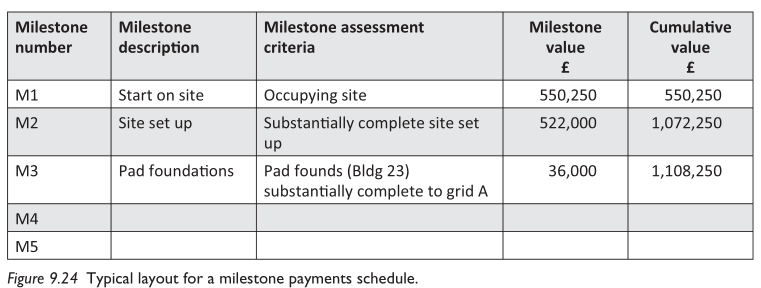Cash flow in construction
Contents |
[edit] Introduction
In general terms, 'cash flow' is the movement of income into and expenditure out of a business (or other entity) over time. If more money is coming into the business than is going out of it, cash flow is said to be 'positive'. If more money is going out, this is negative cash flow.
In construction, however, the term 'cash flow' typically refers to an analysis of when costs will be incurred and how much they will amount to during the life of a project.
Predicting cash flow is important in order to ensure that an appropriate level of funding is in place and that suitable draw-down facilities are available.
[edit] Client cash flow
Until the main contractor has been appointed, client cash flow projections are likely to be based only on agreed fee payment schedules for consultants and a simple division of the construction cost over the likely construction period (or perhaps an allocation of construction cost over an s-curve distribution). It is only when the main contractor is appointed, a master programme prepared and some form of payment schedule agreed that cash flow projections become reliable.
Cash flow projections may be affected by the need for the early purchase of long-lead time items or by items that the client may wish to purchase that are outside of the main contract (such as furniture or equipment).
[edit] Contractor cash flow
Contractors have to have money coming in to pay suppliers and subcontractors and for the day-to-day running of the business. For example, Carillion's cash flow was very low, leading to their liquidation in January 2018.
At the start of any contract, a payment scheme or table is drawn up and agreed with the client or their quantity surveyor, e.g.:
[Brook, M., 2016. Estimating and Tendering for Construction Work. 5th Edition. ed. Taylor & Francis.]
[edit] Supply chain cash flow
Cash flow is also an issue for the construction supply chain, and is a common reason for contractors and sub-contractors becoming insolvent. This can be catastrophic for a project in terms of time and money. It is in the client's interest therefore to ensure that the supply chain is paid promptly.
The government suggest that, 'Historically, it is has not been unusual for lower tier supply chain members to have to wait for up to 100 days to receive payment, which damages their cash flow and can harm their business.' (Ref. Cabinet Office, Project Bank Accounts – Briefing document.)
A number of measures can be adopted to improve payment and so cash flow in the supply chain, including:
In addition, there are a number of remedies for late payment.
[edit] Related articles on Designing Buildings
- Accruals.
- Balance sheet.
- Budget.
- Building society.
- Business administration.
- Cash flow forecast.
- Cash flow statement.
- Commodity.
- Construction supply chain payment charter.
- Credit crunch.
- Demand chain.
- Discounting.
- Discount rate.
- Discounted cash flow.
- Drawdown.
- Earned value.
- Fair payment practices.
- Financial hedging.
- Financial year.
- Microeconomics.
- Net Present Value.
- Payment schedule.
- Profit.
- Project bank accounts.
- Prompt payment.
- Prompt Payment Code boosted to help SMEs.
- Quote.
- Relevant cost.
- Remedies for late payment.
- Retention.
- Solvency.
- Time value of money.
- The Late Payment of Commercial Debts Regulations 2013.
- Trade credit insurance.
- Turnover.
- Whole life costs.
- Working capital.
Featured articles and news
BSRIA Sentinel Clerk of Works Training Case Study
Strengthening expertise to enhance service delivery with integrated cutting-edge industry knowledge.
Impact report from the Supply Chain Sustainability School
Free sustainability skills, training and support delivered to thousands of UK companies to help cut carbon.
The Building Safety Forum at the Installershow 2025
With speakers confirmed for 24 June as part of Building Safety Week.
The UK’s largest air pollution campaign.
Future Homes Standard, now includes solar, but what else?
Will the new standard, due to in the Autumn, go far enough in terms of performance ?
BSRIA Briefing: Cleaner Air, Better tomorrow
A look back at issues relating to inside and outside air quality, discussed during the BSRIA briefing in 2023.
Restoring Abbotsford's hothouse
Bringing the writer Walter Scott's garden to life.
Reflections on the spending review with CIAT.
Retired firefighter cycles world to raise Grenfell funds
Leaving on 14 June 2025 Stephen will raise money for youth and schools through the Grenfell Foundation.
Key points for construction at a glance with industry reactions.
Functionality, visibility and sustainability
The simpler approach to specification.
Architects, architecture, buildings, and inspiration in film
The close ties between makers and the movies, with our long list of suggested viewing.
SELECT three-point plan for action issued to MSPs
Call for Scottish regulation, green skills and recognition of electrotechnical industry as part of a manifesto for Scottish Parliamentary elections.
UCEM becomes the University of the Built Environment
Major milestone in its 106-year history, follows recent merger with London School of Architecture (LSE).
Professional practical experience for Architects in training
The long process to transform the nature of education and professional practical experience in the Architecture profession following recent reports.
A people-first approach to retrofit
Moving away from the destructive paradigm of fabric-first.
New guide for clients launched at Houses of Parliament
'There has never been a more important time for clients to step up and ...ask the right questions'
The impact of recycled slate tiles
Innovation across the decades.
EPC changes for existing buildings
Changes and their context as the new RdSAP methodology comes into use from 15 June.


























Comments
Cash flow is the movement of income into and expenditure out of a business over time. If there is more money going out than in, this is negative cash flow.
Possible cash flow problems may be:
To minimise the risks of future cash flow problems, the firm could establish a financial system that includes: